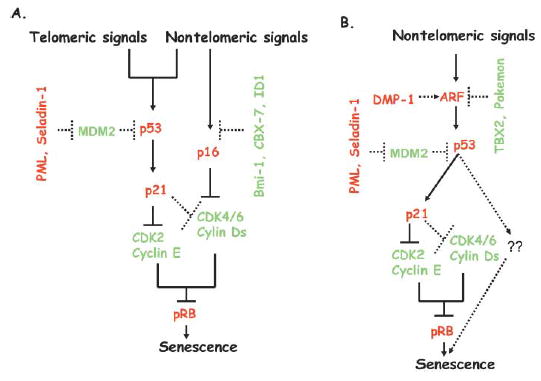Figure 2.

Telomeric and nontelomeric signals induce senescence via tumor suppressor pathways in human and mouse cells
Induction of p21 and p16 by senescence-inducing signals results in inhibition of activity of CDK2 and CDK4/6. Downregulation of activity of these pRB kinases leads to pRB hypophosphorylation, which results in cell cycle arrest during senescence. Regulators of senescence pathways in human and mouse cells include PML, MDM2, ID1, Bmi-1, CBX7, and Seladin-1. In mouse cells, tumor suppressor ARF is negatively regulated by two potential oncogenes, TBX2 and Pokemon, and positively regulated by DMP-1.
A: In human cells, telomeric and nontelomeric signals induce senescence primarily via the p53-p21-pRB pathway. Nontelomeric signals also induce the p16-pRB pathway of senescence in human cells.
B: Mouse cells undergo senescence via the ARF-p53-p21-pRB pathway in response to nontelomeric signals. Mouse cells do not senesce by the telomeric signal-induced pathway of senescence.
Solid lines indicate principal pathways of senescence, while dotted lines indicate auxiliary pathways that can modulate senescence. The red letters indicate tumor suppressors and growth inhibitors, while the green letters indicate oncogenes and growth promoters.
